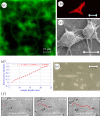Determinants of cell-material crosstalk at the interface: towards engineering of cell instructive materials
- PMID: 22753785
- PMCID: PMC3405766
- DOI: 10.1098/rsif.2012.0308
Determinants of cell-material crosstalk at the interface: towards engineering of cell instructive materials
Abstract
The development of novel biomaterials able to control cell activities and direct their fate is warranted for engineering functional biological tissues, advanced cell culture systems, single-cell diagnosis as well as for cell sorting and differentiation. It is well established that crosstalk at the cell-material interface occurs and this has a profound influence on cell behaviour. However, the complete deciphering of the cell-material communication code is still far away. A variety of material surface properties have been reported to affect the strength and the nature of the cell-material interactions, including biological cues, topography and mechanical properties. Novel experimental evidence bears out the hypothesis that these three different signals participate in the same material-cytoskeleton crosstalk pathway via adhesion plaque formation dynamics. In this review, we present the relevant findings on material-induced cell response along with the description of cell behaviour when exposed to arrays of signals-biochemical, topographical and mechanical. Finally, with the aid of literature data, we attempt to draw unifying elements of the material-cytoskeleton-cell fate chain.
Figures




Similar articles
-
Engineering Cell Instructive Materials To Control Cell Fate and Functions through Material Cues and Surface Patterning.ACS Appl Mater Interfaces. 2016 Jun 22;8(24):14896-908. doi: 10.1021/acsami.5b08658. Epub 2016 Jan 4. ACS Appl Mater Interfaces. 2016. PMID: 26693600
-
Static and Dynamic: Evolving Biomaterial Mechanical Properties to Control Cellular Mechanotransduction.Adv Sci (Weinh). 2023 Mar;10(9):e2204594. doi: 10.1002/advs.202204594. Epub 2023 Jan 19. Adv Sci (Weinh). 2023. PMID: 36658771 Free PMC article. Review.
-
Tuning the material-cytoskeleton crosstalk via nanoconfinement of focal adhesions.Biomaterials. 2014 Mar;35(9):2743-51. doi: 10.1016/j.biomaterials.2013.12.023. Epub 2014 Jan 3. Biomaterials. 2014. PMID: 24388800
-
Three-dimensionally Patterned Scaffolds Modulate the Biointerface at the Nanoscale.Nano Lett. 2019 Aug 14;19(8):5118-5123. doi: 10.1021/acs.nanolett.9b01468. Epub 2019 Jul 3. Nano Lett. 2019. PMID: 31268343
-
Recent progress in stem cell differentiation directed by material and mechanical cues.Biomed Mater. 2016 Feb 2;11(1):014109. doi: 10.1088/1748-6041/11/1/014109. Biomed Mater. 2016. PMID: 26836059 Review.
Cited by
-
The in vitro and in vivo performance of a strontium-containing coating on the low-modulus Ti35Nb2Ta3Zr alloy formed by micro-arc oxidation.J Mater Sci Mater Med. 2015 Jul;26(7):203. doi: 10.1007/s10856-015-5533-0. Epub 2015 Jul 8. J Mater Sci Mater Med. 2015. PMID: 26152510
-
Controlling osteoblast morphology and proliferation via surface micro-topographies of implant biomaterials.Sci Rep. 2020 Jul 30;10(1):12810. doi: 10.1038/s41598-020-69685-6. Sci Rep. 2020. PMID: 32732908 Free PMC article.
-
Biomimetic approaches with smart interfaces for bone regeneration.J Biomed Sci. 2016 Nov 5;23(1):77. doi: 10.1186/s12929-016-0284-x. J Biomed Sci. 2016. PMID: 27814702 Free PMC article. Review.
-
Spatio-Temporal Control of Cell Adhesion: Toward Programmable Platforms to Manipulate Cell Functions and Fate.Front Bioeng Biotechnol. 2018 Dec 4;6:190. doi: 10.3389/fbioe.2018.00190. eCollection 2018. Front Bioeng Biotechnol. 2018. PMID: 30564573 Free PMC article. Review.
-
Lateral Spacing of TiO2 Nanotubes Modulates Osteoblast Behavior.Materials (Basel). 2019 Sep 12;12(18):2956. doi: 10.3390/ma12182956. Materials (Basel). 2019. PMID: 31547276 Free PMC article.
References
-
- Lehnert D., Wehrle-Haller B., David C., Weiland U., Ballestrem C., Imhof B. A., Bastmeyer M. 2004. Cell behaviour on micropatterned substrata: limits of extracellular matrix geometry for spreading and adhesion. J. Cell Sci. 117, 41–5210.1242/jcs.00836 (doi:10.1242/jcs.00836) - DOI - DOI - PubMed
-
- Flemming R. G., Murphy C. J., Abrams G. A., Goodman S. L., Nealey P. F. 1999. Effects of synthetic micro- and nano-structured surfaces on cell behavior. Biomaterials 20, 573–58810.1016/S0142-9612(98)00209-9 (doi:10.1016/S0142-9612(98)00209-9) - DOI - DOI - PubMed
-
- van Kooten T. G., Spijker H. T., Busscher H. J. 2004. Plasma-treated polystyrene surfaces: model surfaces for studying cell–biomaterial interactions. Biomaterials 25, 1735–174710.1016/j.biomaterials.2003.08.071 (doi:10.1016/j.biomaterials.2003.08.071) - DOI - DOI - PubMed
-
- Dowling D. P., Miller I. S., Ardhaoui M., Gallagher W. M. 2011. Effect of surface wettability and topography on the adhesion of osteosarcoma cells on plasma-modified polystyrene. J. Biomater. Appl. 26, 327–34710.1177/0885328210372148 (doi:10.1177/0885328210372148) - DOI - DOI - PubMed
Publication types
MeSH terms
Substances
LinkOut - more resources
Full Text Sources

